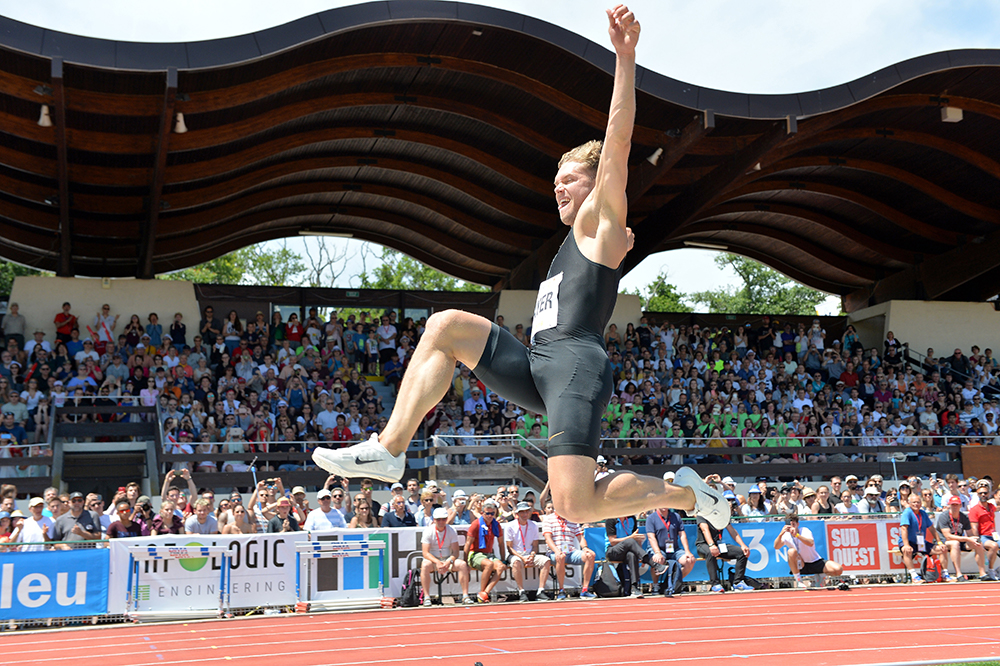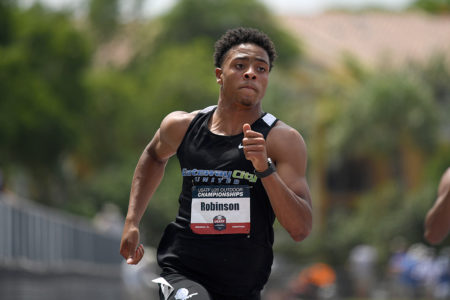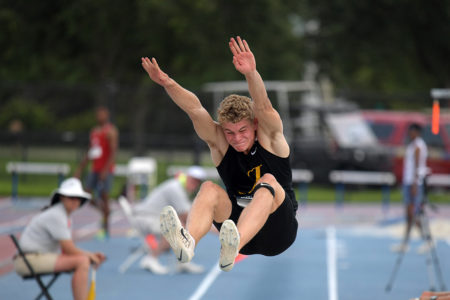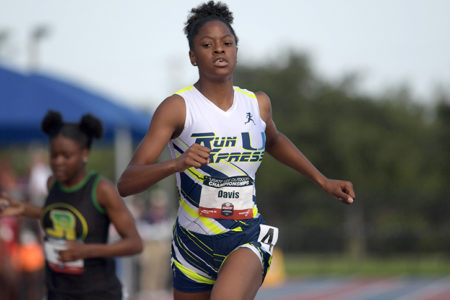Here’s this month’s collection of generally off-track activities that have gone a long way towards shaping the way the sport is headed. The biggest off-track story of the month, the almost-suspension of Christian Coleman, is covered here.

Briana Williams’ Fate Up In The Air
As noted in the introduction to our HS Girls All-America team, we were unable to choose a Girls Athlete Of The Year for this issue. That process came to a grinding halt in late August with the revelation that 17-year-old Jamaican sprint star Briana Williams—a Florida high school junior—had turned in a positive test at the Jamaican Championships in June, where she set a HS Record 10.94. The substance, the diuretic HCTZ (Hydrochlorothiazide), supposedly came from a contaminated cold medicine that Williams used when she fell ill at the nationals. Williams’ camp subsequently had the medicine tested at a laboratory in Michigan, which forwarded the results to the Jamaican federation. Diuretics have no performance-enhancing properties of their own, but can be used as a masking agent for other banned drugs.
Williams’ attorney, Emir Crowne, says, “Our primary position will be that Ms. Williams bears no fault in the circumstances and there should be no sanctions levied against her… It will be an uphill battle, but this is one of the truly genuine times when there was nothing more that the athlete could do in the circumstances.”
A hearing with the Jamaica Anti-Doping Commission has been set for September 23–25. The timing is exceedingly tight, but Jamaica has entered Williams for the World Championships (which begin on the 27th) and hopes she can compete should the panel opt not to disqualify her, but the IAAF would have to sign off on such a decision as well. In addition to a complete exoneration. JADCO has two other options: a ban for up to 4 years or a partial ban. Each of the 3 options would have a different effect on our AOY voting, results of which we hope to be able to reveal in the October edition.
Mayer Wants Multi-Eventers In The DL
Kevin Mayer had a great day in a special triathlon at the Paris Diamond League, scoring PRs in a pair of events. But the decathlon WR holder knows that that was just a special appearance, and he wants more multi-event performances in the DL. “This is a very important goal,” he said before the French meet. “If this works we want to be treated as normal athletes, like Diamond League athletes who have fees and prize money and appearance money. When international multi-event athletes from abroad—from China or the United States—come to compete, they come as volunteers, for nothing. It will be very interesting to convince the Diamond League organizers to put this on the same scale and have the same program in terms of fees as other athletes.” He continued, “But this is not to gain money, it is to build something that is not only given one year and then stopped because they say it doesn’t work, but that will be something that will stay for later generations of talented multi-athletes.” At a time when the DL braintrust is trying to tighten up meet timetables, adding a 3-event discipline sounds like it could be a hard sell.
Tokyo 200/400 Doubles: Norman No, SMU “Yes”
Winning an Olympic long-sprint double in ’96 confirmed Michael Johnson’s status as an international superstar. Marie-José Pérec also scored big with 200/400 golds in Atlanta. Too bad the powers that be haven’t continued to make such easier to accomplish; as currently constituted the Tokyo ’20 schedule militates against such a combo.
U.S. star Michael Norman, who has PRs of 19.70 and 43.45, said in Brussels, “These next 2 years, I really want to just focus on my individual event, make sure I get a medal in the 400m. Further down the line, hopefully I can drop down to the 200m, go for the double.” Bahamian standout Shaunae Miller-Uibo (21.74/48.97), who already has an Olympic 400 gold under her belt, is actively seeking to have the Japanese timetable modified so she can double. Says her manager, Claude Bryan, “We have already petitioned the IAAF for Tokyo.” Modifying the existing schedule has been made a little tougher by the addition of the mixed-sex 4×4, meaning more 400s to fit into the overall scheme of things.
Chris Derrick Out Of Chicago Marathon
Running in the Bobby Crim 10-Miler in Michigan in late August, pointing towards the Chicago Marathon, Chris Derrick stepped in a pothole and the result wasn’t pretty. “I’ve sprained my right ankle a few times before, so I thought it was a sprain,” he told Runner’s World. “I was full of adrenaline and mad about the race, so it didn’t feel that bad. I ended up walking on it a mile back to the start line where the medic tent was. By then, I could tell it was something worse than a sprain, because the swelling was different. Instead of my whole foot being swollen, I still had an ankle—all the swelling was around the fibula.”
The 28-year-old Stanford grad later posted on Instagram, “Recorded my first DNF today, but I think I got my money’s worth. I was running in the pack just before the mile and unfortunately could not see the ground ahead of me. I landed perfectly on the edge of a big ol’ pothole and fractured the head of my fibula. The kindly doctor who read my x-ray said that of the ankle fractures, this is the best one. So I got that going for me.” He’s optimistic he’ll be able to return in time for the OT Marathon at the end of February.
No van Niekerk At The World Champs
In early September 400 WR holder Wayde van Niekerk announced that he won’t be going for a 3-peat in Doha, as he’s still rehabbing from his late-2017 knee injury. “I’m still positive and I’m just taking things day by day, respecting all the calls made by the doctor and respecting my body,” he said in a sport24 report. “For me it’s just about listening to my body and taking it from there. My main goal is to look after my body and when the opportunity comes, I’ll take it. For now I’m not rushing myself or putting pressure on myself. I’m extremely happy and at peace with where I am.”
His doctor, Louis Holtzhausen, said, “The medical teams did all we could to have him ready for the IAAF World Championships, but it was just not possible. However, he has successfully returned to track training and all indications are that he will recover more rapidly from now on.”
New Tests Show Old Blood Doping
One of the favorite performance-enhancing techniques used by endurance athletes is “blood doping” whereby the athlete’s own blood is removed, then reinfused later to increase the red blood cell count. Research by the University Of Lausanne suggests that 18% of endurance athletes used such procedures at the ’11 & ’13 World Championships. Women apparently outnumbered men in this category, 22% to 15%. Agence France-Presse reports that the report’s authors had access to blood samples from 1222 athletes who took part in endurance events in Daegu and Moscow. The IAAF’s introduction of the “biological passport” in ’11, the report suggests, failed to significantly lower blood doping in 2013. But it added: “The further development of the Athlete Biological Passport with a careful monitoring of biological parameters still represents the most consistent approach to thwart athletes using undetectable prohibited substances or methods.”
Another Look At A Diack Contract
The fallout in the Lamine Diack case has continued with the news that the controversial 10-year marketing and media rights partnership with the Japanese firm Dentsu was renegotiated by the IAAF in 2018, after Diack’s departure from the international governing body. The contract was unilaterally signed by Diack shortly before the end of his IAAF presidency. There had not been any bidding process. Few details are available about the renegotiation, but there has been speculation that the changes are tied to the profit-sharing formula as well as the levels of collaboration.
According to SportBusiness, the original contract contained “unusual provisions” that are not standard practice.
Meanwhile, French investigators have asked the Swiss to raid the offices of Athletic Management Services, charging that AMS played a “central and essential role” in embezzling funds from the IAAF. According to the indictment, AMS ceded certain rights to a firm controlled by Papa Massata Diack, the son of the IAAF president, which allowed him to earn “exorbitant” commissions.
In related news, Habib Cissé, Diack père’s former legal advisor, has been banned for life by the IAAF for helping to cover up Russian doping violations.
Montana Transgender Eastwood Running XC
Distance runner Juniper Eastwood found herself the center of controversy this fall when the story emerged that she would be competing on Montana’s women’s cross country team. Eastwood is transgender and had previously competed for the Grizzly men’s team as Jonathan, with PRs of 1:53.17, 3:50.19 and 14:38.80. Those numbers would make her the world’s best female middle-distance runner.
Once the news broke, passions rose on both sides of the controversy—would Eastwood make a travesty of NCAA women’s running? Or was criticizing her return to competition an attack on her civil rights?
Lost in much of the arguing were the fine points of the NCAA’s policy on transgender participation, that is, an athlete transitioning to female is allowed to participate provided they have undergone a year of testosterone suppression. What’s missing from the NCAA guideline is any specificity on target testosterone levels or a verification process.
In Eastwood’s case, a rewriting of women’s records doesn’t appear to be in the offing. In her first race for the Grizzly women, she placed 7th in 14:33 for 4K, 20 seconds behind the winner.
Lananna On The Move Again
The man who had become synonymous with Eugene track is back in the coaching ranks, effective immediately. Vin Lananna, the ’16 U.S. men’s Olympic coach, has moved east to take the director of track & field and cross country position at Virginia. Lananna, who previously coached at C.W. Post, Dartmouth, Stanford and—after a stint as Athletic Director at Oberlin—Oregon. He gave up the Duck coaching position prior to the ’12 season, but continued to serve as Associate AD. From ’08 to ’19; he was also president of TrackTown USA until mid-’18.
The move comes as something of a surprise, but the 66-year-old New York native has been in a holding pattern of sorts. Elected president of USATF in ’16, he was placed on administrative leave two years later. He has a pending grievance on the issue.
He also led the bid effort that landed Eugene the ’21 Worlds, though he is no longer part of that organization.
He told the Portland Oregonian, “I made a 7-year plan in 2009. It had 13 things on it. We completed 13 of 13. I’m proud of what we accomplished. And I feel the future at Oregon is in great hands.” He added, “What this made me do is really think about what is import, what brings me joy. I’m passionate about getting athletes to perform.” He will also handle Associate AD duties in Charlottesville.
What’s Up With Russia?
The IAAF panel that is monitoring the ongoing exclusion of Russia as an eligible nation will be meeting prior to the Worlds, but according to reports is unlikely to ease up on the suspension. That will mean that cleared Russian athletes again will be competing as Authorized Neutral Athletes (ANA). The apparent remaining sticking point for the IAAF is that WADA has not yet completed its analysis of data from the Moscow laboratory that was the nexus of much of the Russian doping system. “It has been a long process,” says IAAF president Seb Coe. “Slowly but surely we have started to get change. And the biggest piece of that is the work the AIU is doing around the data.”
Russia is taking heat from some of its own people. High jump star Mariya Lasitskene again publicly criticized the federation’s slow pace at reform, saying, “Cleaning up your own house would help to put order in the federation, the national team. That should have been done a long time ago.” And RUSADA chief Yuri Ganus called on the federation directors to resign, saying, “The scale of the backlog is crazy. It’s the problem of the system.”
The IAAF has made no predictions whether the federation will be back in the fold in time for the Olympics. However, as in ’16, any Russians who have been granted ANA status will be able to wear national colors at the Games, per the CAS ruling prior to Rio.






